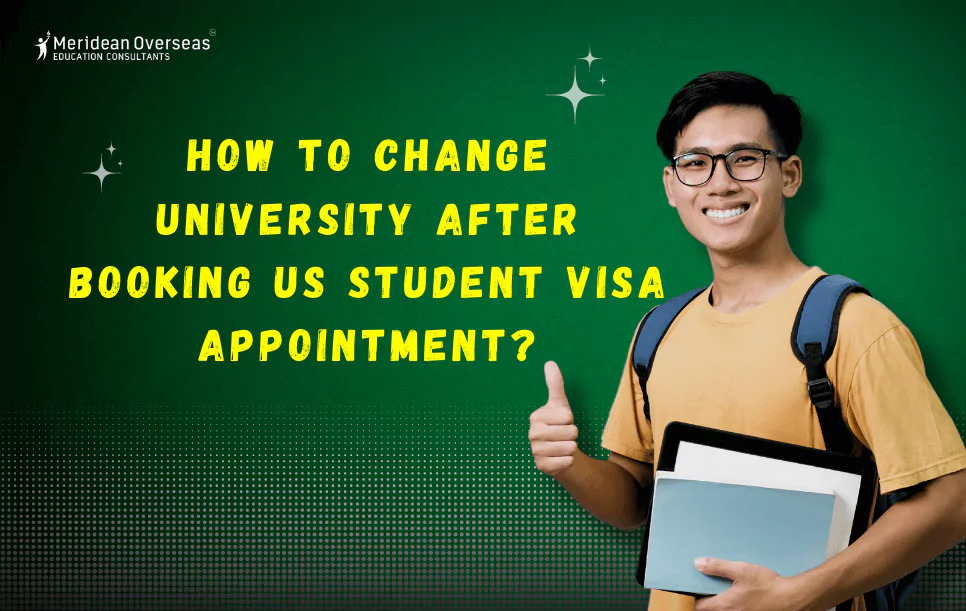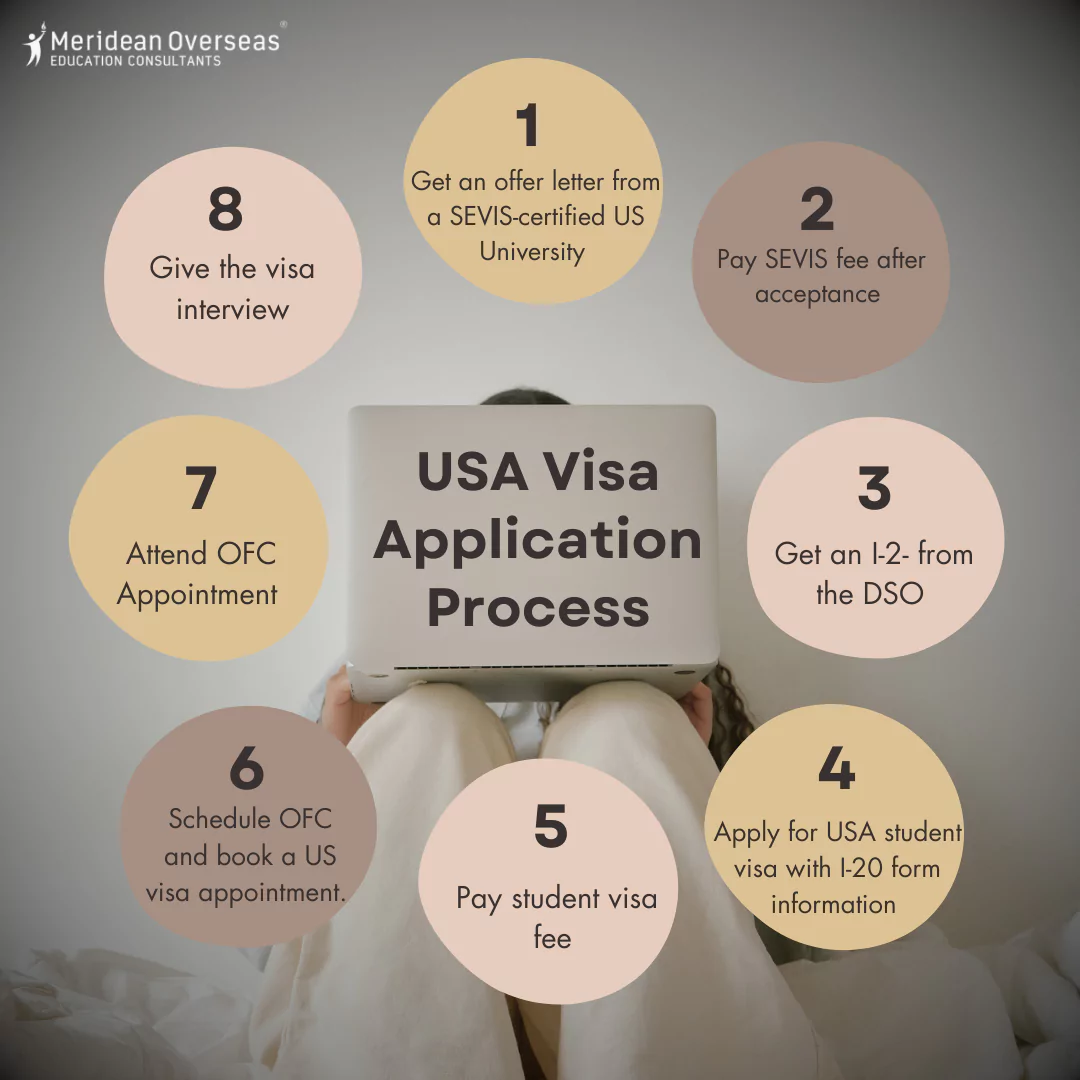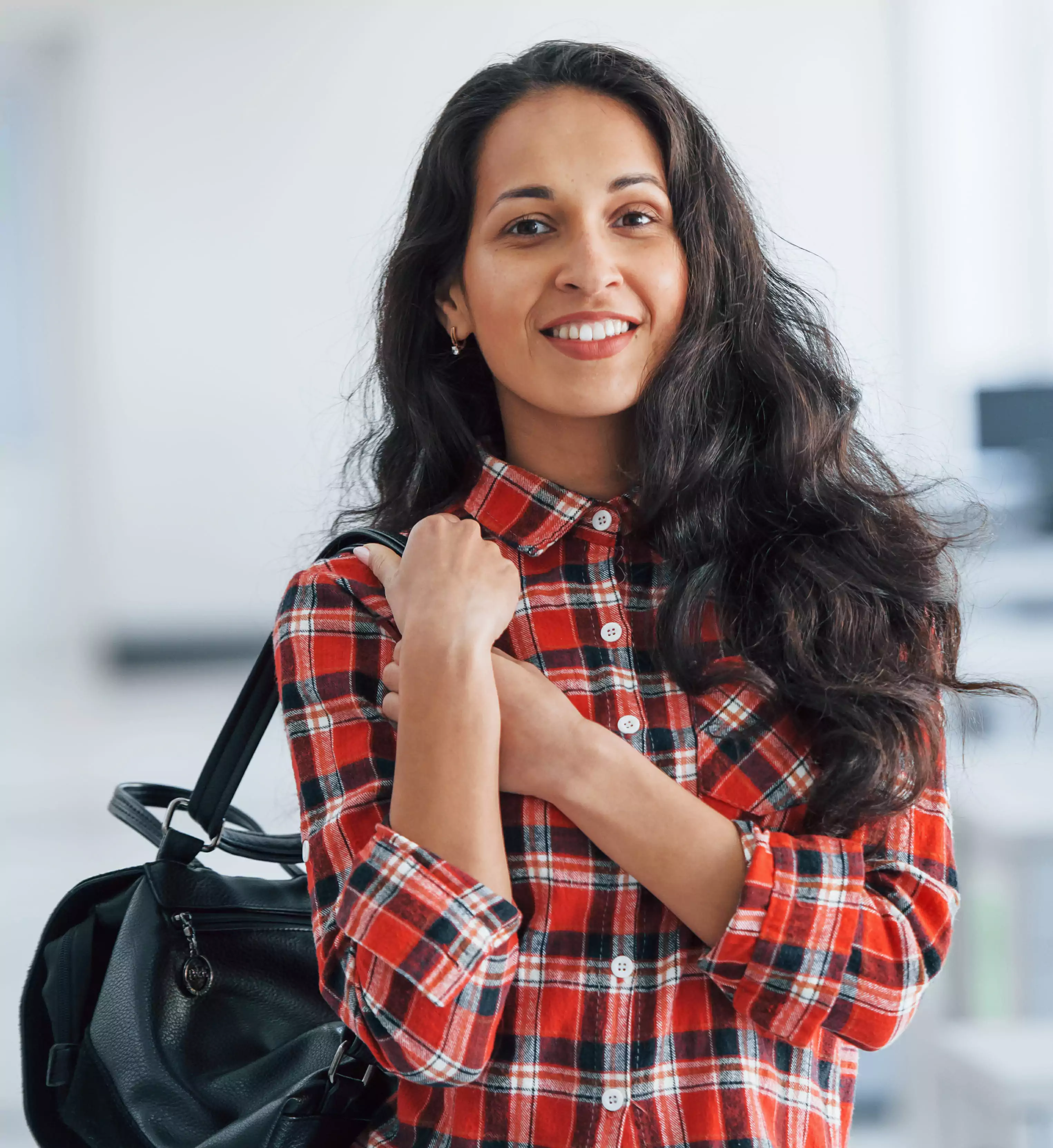
Announcements

Announcements

Meridean Overseas
Updated On 21 June 2024 & Read Time 13 minutes
17k
The United States is an excellent destination for pursuing higher education. Every year, many Indian students fly to study in the United States. The explanation is that most of the world's best colleges are in the United States. The country boasts excellent educational standards and seeks to empower students through research-focused institutions.

To study in the United States, every international student must first get a student visa, and they need to book a US student visa appointment. In this relation, this blog explains the types of USA student visas, the application process, and what to do if a student wants to change universities after booking a visa appointment.
Table of Contents
Of all the requirements to study in the USA, acquiring a student visa is one of them, and you need to book a US student visa appointment. However, the USA student visas are divided into three categories, i.e., F-visa, M-visa and J-visa.
This form of US student visa is available to international students seeking to pursue a degree at a recognised US university and those seeking to acquire English at a school or intensive English language course.
There are three categories of F-visas:
F1-Visa
F2-Visa
F3-Visa
Apply for American Visa: Who can Apply for F-Visas?
Acceptance letter of a university recognised by the Student Exchange Visitor Program (SEVP).
Full-time student status is required.
If you cannot provide valid evidence that you intend to return home after completing your educational program, it will be easier to acquire an F1 visa.
You must provide proof of enough funds to pay for your expenses throughout your journey.
Proof of English proficiency test, score of IELTS/TOEFL or any other test scores accepted by the particular university is a requirement.
Documents Required
Two passport-size photos
Form I-20
Results of standardised exams
Valid Passport
Proof of payment of Visa application fees
Academic Credentials
Proof of purchase of health insurance
M-visa is another visa type offered to international students who want to enrol in a US university for non-academic or vocational courses.
There are 3 M-category US student visas:
M1-Visa
M2-Visa
M3-Visa
Apply for American Visa: Who can Apply for M-Visas?
A student must be admitted to a school approved by the Student Exchange Visitor Program (SEVP).
It will be challenging to obtain an M1 visa if you cannot demonstrate that you intend to return home when your studies program is completed.
You must demonstrate adequate finances and savings to pay for studying and living in the United States.
IELTS or TOEFL results are acceptable proof of ability to communicate correctly in English.
Documents Required
Two passport-sized photos
Form I-20
Proof of financial stability
Valid Passport
Proof of payment of Visa application fees
Academic Transcripts
J-Visas are intended for international students participating in US programs that promote cultural exchange. All students pursuing training in healthcare, industry, or another subject must meet the program's eligibility requirements and be funded by a corporate or government agency. It is an exchange program.
There are two types of J-visas:
J1-Visa
J2-Visa
Apply for American Visa: Who can Apply for F-Visas?
There are different categories of J-visa for the USA for various programs, and all have different requirements. The list below shows the general requirements for a J-type visa.
Camp Counselor
Intern
Physician
Short-term Scholar
Student-school/university level
Teacher trainee
Au Pair and EduCare
Government Visitor
International Visitor
Professor and Research Scholar
Specialist
Summer work Traveller
Documents Required
Photograph
Visa Fee payment receipt
Form DS-2019
Form DS-7002
Valid Visa
J1 Visa Health Insurance
Non-immigrant Visa Application form
Here's a comparison of the many US education visa options you should know when to apply for a degree in the US:
|
Particulars |
F1 Visa |
J1 Visa |
M1 visa |
|
Average Cost |
350 USD |
300 USD |
160 USD |
|
Duration Post Completion of Courses |
Up to 12 months |
Up to 2 years |
Up to 3 years |
|
Work Benefits |
20 hours/week |
Varies |
For 6 months part-time on campus |
A USA visa is not granted easily, so one must make sure to apply with the correct documents. Here is the step-by-step process for a USA visa application, but before that, you need to book a US student visa appointment. The steps involved in the visa application process are as follows:

Get an offer letter from a SEVIS-certified US University or college.
After getting accepted into the university, one must pay the SEVIS fee.
Get an I-2- from the DSO
Apply for a USA student visa with information on the I-20 form
Pay student visa fee
Schedule OFC (Offsite Facilitation Center) and book a US student visa appointment
Attend OFC Appointment
Give the visa interview
Students facing problems with Visa applications can contact a study abroad consultant. They can’t apply for a visa on your behalf but they can guide you through the process to make it a hassle-free process. They can also guide you with formats and content and can also arrange mock-up visa interviews to make you aware of the process.
Embark and excel in your study abroad journey with our expert team!

There are several reasons why students decide to change their university after applying for a visa. Sometimes, the student applies to more than one university and then applies for a student visa once they receive confirmation from one university. However, when the student gets an offer letter from a better university after applying, they can change the university in the visa application.
Sometimes, students get an offer letter from a different US university ready to grant them a scholarship. As the cost of studying in the USA is enormous, in this scenario, a student chooses the university with a scholarship, which is more affordable. Then, students also seek to change their university after securing a US visa appointment.
The university change process differs from situation to situation. The following are some common scenarios where moving universities necessitates alternative procedures after booking a US student visa appointment:
Scenario 1: The SEVIS fee is paid, and the DS-160 is submitted, but the visa payment still needs to be made.
In this scenario, students only have to transfer the SEVIS from one university to another. They are not required to pay the fees again for the changed university.
The process of changing the university:
To transfer the SEVIS fee to another university, visit the Student and Exchange Visitor (SEVP) I-901 SEVIS fee processing online and complete the payment status form.
Click the transfer button.
The webpage will urge you to provide your SEVIS ID and school code for the new university. Enter the correct information and then submit it.
You will be notified by email about the transfer request.
Your transfer will be confirmed or denied via a second email. Print the updated information for future use if your transfer request is authorised. If your request is declined, you will receive an email explaining why.
Once you receive the updated SEVIS number, follow the steps below:
Now that you have submitted the DS-160 form for the previous university, you have to refill the new form for the new university.
Complete the new DS-160 form with information about your new university.
Submit the revised DS-160 form to get confirmation.
Schedule an appointment.
Take the updated DS-160 confirmation document to your booked appointment.
Scenario 2: DS-160 is submitted, visa payment is made, and an interview slot has been booked.
In this particular instance, you must follow the instructions above
Create a new DS-160 form
Enter the SEVIS number for the university you intend to attend, and submit it.
Since you've already paid for the visa and scheduled the interview, you simply need to login to your account on the CGI Federal US visa website and change:
DS-160 confirmation number
SEVIS ID
Note- You do not have to pay the fees again, as you only booked the US student visa appointment and did not attend the interview.
If you cannot update your SEVIS ID or DS-160 confirmation number on the CGI federal website, bring both the old and new DS confirmation papers to your OFC interview and notify the officials of the university change.
Scenario 3: The student has already attended the visa interview
This is the trickiest situation that a student can end up in. If the student is being granted the F-1 student visa and then decides to change university, then these steps have to be followed:
Request I-20 form from new university
Get a new DS-160 form and transfer SEVIS fees, as explained earlier.
Pay the visa fee again.
Schedule the second interview and appear for a visa interview once again.
There is one more method to change the university after acquiring your student visa:
Accept admission to the first university.
Once in the United States, notify the university that you want to transfer the I-20 to University B. At this time, you must formally verify acceptance to the second university.
Then, university 1 will start filling out the required forms and submitting them to university 2.
After that, University 2 enrols you, creates a new I-20, and sends it to you.
It is tough to preserve all your I-20 forms from University A and University B and keep your student status 'Active' by adhering to M1 or F1 Visa regulations.
Note- Do not allow University A to 'terminate' your SEVIS status, or you may be forced to leave the country and start the entire process of obtaining a student visa again.
Changing universities and SEVIS IDs on a student visa application is allowed. However, you are strongly advised to schedule your US student visa appointment after obtaining the initial university acceptance letter. If you believe a superior university will approve your application, be patient, wait for their acceptance letter, book a US student visa appointment and attend the interview again.
In conclusion, the blog discusses three types of US visas: F-visa, M-visa, and J-visa, wherein you can check the eligibility and required documents. Various students go through these problems after they receive an offer letter from a top university. If the student has not appeared for the visa interview, the process of changing university is not tough. But, to avoid these kinds of situations, students should always wait before scheduling their visa interview. Overall, as International students always apply to various universities, it is never advisable to rush to schedule a visa interview after getting an offer letter from one university. Thus, if you feel you might get into a better university, waiting for a visa interview is always better. Visa interviews should be booked only after you have received answers from all the universities you've applied to.
Studying abroad is great as long as the procedure seems smooth and easy. However, the only way to make your journey hassle-free is to get help from experienced education counsellors. Counsellors at Meridean Overseas Education Consultants(MOEC) can help you make applications to the right universities and guide you through booking visa interviews at the right time. Visit us and get one-to-one counselling, or avail yourself of free video counselling via our website. We will be happy to help you, so please do not hesitate to contact us at application02@meridean.org or 1800-1230-00011.
1. What is the processing time for obtaining a student visa to the United States?
After completing all admission and visa processes, you usually receive your US visa in about 120 days. You can obtain a student visa in three days or three months, depending on your situation.
2. How do I transfer SEVIS from one university to another after booking my F1 visa appointment?
If you have already paid the SEVIS cost, simply log in to the Student and Exchange Visitor (SEVP) I-901 SEVIS fee processing website and locate the fee paid before; there, you will discover a transfer option that allows you to shift your SEVIS from one university to another.
3. Do we get a return for cancelling our visa appointment?
To be eligible, applicants must initiate a refund request form within 30 days of cancelling their visa appointment. The process can be done online.
4. What is the SEVIS fee's validity period?
The SEVIS charge is valid for 12 months from the payment date. If you do not receive your visa within 12 months of paying the fee, you must reimburse it.
5. Is it viable to change universities after arranging an appointment for a US student visa?
Because you filed the DS-160 for the prior institution, you must fill out a new form for the new university. Fill out the new DS-160 form with information about your new university. Submit the updated DS-160 and print the confirmation. Schedule an appointment.
6. How can I transfer from one university to another?
The first one is within the university. In this instance, you can enrol in a college linked to the institution where you previously studied. The second one is migration to another university. In this situation, you must choose a college and apply to the university associated with it for a migration.
7. Is the SEVIS money refunded if I am denied a visa, change of status, or reinstated?
No. The SEVIS cost is non-refundable once paid unless paid by mistake, even if your visa application is refused or you decide not to go to the United States after the visa has been issued.
8. Can we book F1 visa slots without a SEVIS ID?
No, you can't. The DS 160 form asks which visa type you are asking for. When you pick an F1 Visa, it asks for your SEVIS ID, which is only written on your I-20. If you do not have an I-20, you cannot attend the student visa interview.
9. How often can I alter my visa slot?
The number of times you can modify your visa slot may differ based on the regulations of the US consulate or embassy where you have scheduled the appointment. You should inquire with the relevant consulate or embassy about their policy on postponing visa appointments.
10. Is it possible to change institutions after having a visa interview?
Yes, it is possible to change institutions after the visa interview. However, this can be a more involved process. It usually entails amending your paperwork and, in certain situations, undergoing a second visa interview. The viability of this alteration depends on various conditions, so careful evaluation is recommended.

Contact MOEC Experts for Study Abroad Guidance!
By using our site, you agree to our use of cookies.

Hurry up before admissions close.

